Cooperative Extension: 4-H
Lesson 2: stress less — teen stress management.
- Youth will gain tools to identify stress by understanding the effects that stress can have on a person.
- Youth will learn and practice a variety of coping strategies designed to reduce the effects of stress on the body; youth can keep these strategies in their life ‘toolbox’.
- Youth will learn to reframe their own negative self-talk and that of others as it relates to stress.
Time to Complete: 45 minutes (1 hour with optional activity)
Level: Grades 7-12
- Teen Stress Less (Powerpoint)
- My Life App: Free Download, to be used in the “ Coping Strategy ” section
- Negative Friend Talk (PDF)
- Portable Speaker for coping strategy app (optional)
- Flipchart Paper (optional activity)
- Markers (optional activity)
No specific setup required.

Special Considerations
Stress can be extremely difficult and overwhelming. Seeking professional help from a local counselor or other trained professional is always an encouraged option. If you or someone you know would like to talk to another teen about their mental health, please contact Teen Line . If you or someone you know is struggling with their mental health, feel they cannot reach out to someone locally, and are concerned for their safety, please contact Talk to Someone New (Suicide Prevention Lifeline website).
Introduction (5 minutes; slide 2)
The goal of this lesson is to educate youth on the effects of stress and how they can combat and cope with stress in their daily lives and the lives of others. Youth will start by identifying what the effects of stress are, and then have the opportunity to practice a variety of coping strategies that can help to reduce these effects on the body.
Throughout the lesson feel free to pick and choose the amount of statistics to read to youth based on group size, age, and time limit. The discussion questions are most important.
What is Stress?
We hear a lot about stress in our daily lives but what exactly is it? Stress is a normal reaction the body has in response to any change, positive or negative, that requires a response or adjustment. [1] Stress can be short or acute, occurring only temporarily, or more long term, routine or chronic, occurring over days, weeks, or more. [2] Stress can be in response to something positive in a way that keeps you motivated or alert, like graduating from school. Stress can also be in response to negative change, such as having a loved one with a chronic illness, where the stress could be continuous without much relief between stressful moments. [3] Too much stress or a chronic level of stress can cause harmful effects on the body.
Did you know that in a 2018 poll, 45% of teens said they were stressed all of the time. 37% said they were stressed sometimes. Only 6.3% of teens said they were never stressed.
Ask: Can you guess what the biggest stressor was? Answer: 27% of teens are most stressed by relationships (friendships were only 4.6%). 24% are most stressed by teachers. [4]
What are some effects of stress? (7 minutes; slide 3 (show after Step 2: brainstorm session))
- Ask youth: “By a show of thumbs, rate how much stress affects your daily life. Thumbs up = no stress/impact; thumb in the middle = some stress/impact; thumb down = a lot of stress/impact; and thumb can be anywhere in between.”
- Now that youth know what stress is, brainstorm as a whole group some possible physical, mental or emotional effects stress can have on a teen. With larger groups this step may be done in smaller groups and reported out.
- Show slide 3, which shares some of the effects that stress can have on teens. [5] Following this, ask youth again, “Using the new knowledge you have, by a show of thumbs rate how much stress affects your daily life. Thumbs up = no stress/impact; thumb in the middle = some stress/impact; thumb down = a lot of stress/impact; and thumb can be anywhere in between.”
- Were any of these effects of stress a surprise to you? If so which ones and why?
- Were you surprised by the number of people in the room who had no stress? What about those with a lot of stress? Why or why not?
Add-on Activity: Draw the Effects of Stress (15 additional minutes)
Instead of completing step 2 above, divide youth into smaller groups of four to six and give each group markers and flipchart paper. Give youth 10 minutes to draw what they think the effects of stress on a teen look like. Youth can accomplish this task anyway they see fit but if youth get stuck have them start with an outline of a human body. Then ask them to think of what they think stress can do to a person physically, mentally or emotionally and how that can be visually represented. Have each group share their picture and the effects that they came up with. Show slide 3 following presentations.
Coping Strategies (25 minutes)
What is a coping strategy.
A coping strategy is the thought or action someone uses to deal with a difficult situation . [6] Just like stress, coping strategies can be either positive or negative. When asked what resources they use to help with stress the highest percentage of teens, 44%, responded that they use apps or online resources to cope. The second most common response from teens, 34%, responded that they do nothing for their stress. [7]
Mindful Breathing Exercise using the My Life App (5 minutes; slide 4)
- Breathing exercises are helpful to relax, reduce tension, and relieve stress because when you breathe deeply it sends a message to your brain to calm down and relax, which the brain then sends to the body. [8]
- If you choose not to download the app you may use this 3-minute Mindful Breathing Meditation (YouTube video) , which uses the same mindful breathing exercise. If you choose to download the app (recommended), open it, and click on Explore along the bottom menu. From the Explore Menu pick Slay Your Stress, and Mindful Breathing, choose either Jamie or Grecco, 3 minutes. Complete the activity.
- Is this different from before the exercise? How so?
- Did you notice anything about yourself that you hadn’t noticed before (a spot of tension or relaxation)?
Additional Activities
Have more time? Here are some of our favorite, short, free activities for stress from My Life , or feel free to explore and find your own:
- Kindness — 3 or 6 minutes
- Relax, Ground and Clear — 7 minutes
- Body Scan — 8 minutes
Free Apps to Help Positively Cope with Stress (3 minutes; slide 5)
- Discussion of additional apps on slide 5, designed to develop stress-coping strategies.
Brainstorm Coping Strategies (6 minutes; slide 6 (show after brainstorm session))
- So far we have discussed positive ways to cope with stress but there are negative alternatives. Ask youth to brainstorm just a few (3-6) negative ways someone could cope with their stress. Some possible negative coping answers may include substance use, risky sexual behavior, withdrawing/avoiding others/skipping school or activities, anger/violent behavior/bullying, overeating/not eating enough, self-harm, etc. [9]
- Now ask youth what additional positive ways they know of to cope with stress. If youth get stuck, prompt them to think of things they like to do to relax and unwind. Turn to Slide 6 to show youth some possible options.
- Possible Answer: Negative coping strategies help you feel better for a short period of time but do not help to solve the original source of stress. Positive coping strategies can help you feel better longer because they are better for your health and wellbeing than the negative alternatives.
Retrain the Brain (17 minutes)
Your mind is a powerful thing. When stressors strike, not only does your brain trigger your body to react in a fight, flight, or freeze response but it can also create a string of negative self-talk which can be detrimental to the process of coping with stress.
Reframing Negative Self-Talk (slide 7)
- Use the prompts on slide 7 to discuss positive and negative self-talk and its effects on coping with stress. Self-talk is the constant stream of thoughts that go through someone’s head daily. Positive self-talk is not about ignoring the bad, but rather about approaching and reframing an unpleasant situation into a more positive one. Some benefits of positive self-talk include lower rates of depression, less distress, greater cardiovascular health, and better ability to cope with stress. When practicing positive self-talk don’t say anything to yourself that you wouldn’t say to someone else. In other words, be kind and encouraging to yourself. If a negative thought enters your head, evaluate it rationally and address it with positive affirmations. [10] Practice makes progress; it’s important to practice positive self-talk often in order for it to become more natural for you. Another way to practice positive self-talk is to write yourself positive notes. Consider writing yourself a positive note and sticking it somewhere you’ll see it every morning, like your bedroom door or bathroom mirror.
Handling Negative Talk and Stress of Others (slide 7)
- As mentioned, everyone feels the effects of stress. Sometimes we may not be stressed but our friends or family are, and their stress boils over and affects us. Slide 7 shows some ways that you can cope with the stress of others. [11]
- Divide youth into groups any way you choose or try this fun suggestion: Have youth line up and close their eyes (if they’re comfortable). Assign youth one of five animals (or however many groups you’d like to have one through five): duck, chicken, cat, dog, sheep. Have youth open their eyes and make the noise of the animal they were assigned. Acting like their animal is encouraged for added fun. Youth will group together with others of their same animal group.
- Ask youth to find the card on the wall with their animal on it.
- Youth will then brainstorm ways in which they could kindly, yet firmly help to resolve the situation so that they can then apply it if they are ever in this situation.
- Have a participant read aloud the scenario and then give their brief responses and reasoning.
- The key to any response is coming from a place of compassion, and friendship, and making the discussion into an “I message.” The intent is not to upset the other person or to permanently end the relationship, but rather to let them know that their stress and negativity is impacting you in a negative or heavy way which is bad for your own stress level. [13]
Wrap – Up Discussion (2 minutes)
- Knowing what you know now about the effects of stress is there anything that you plan to change in your life to reduce your stress?
- Do you plan to use any of the coping strategies you learned today? If so, which ones and why?
- What questions do you still have about stress?
[1] Cleveland Clinic. Stress .
[2] National Institute of Mental Health, 5 Things You Should Know about Stress .
[3] National Institute of Mental Health, 5 Things You Should Know about Stress .
[4] 45% of Teens Say They’re Stressed “All the Time,” Turn to Online Resources and Apps for Help Says Poll on Stress and Mental Health .
[5] Mayo Clinic. Stress symptoms: Effects on your body and behavior .
[6] Centre for Studies on Human Stress. Coping Strategies .
[7] 45% of Teens Say They’re Stressed “All the Time,” Turn to Online Resources and Apps for Help Says Poll on Stress and Mental Health .
[8] University of Michigan Medicine. Stress Management: Breathing Exercises for Relaxation .
[9] American Academy of Pediatrics. Just for Teens: A Personal Plan for Managing Stress (PDF) .
[10] Mayo Clinic. Positive thinking: Stop negative self-talk to reduce stress .
[11] American Academy of Pediatrics. Just for Teens: A Personal Plan for Managing Stress (PDF) .
[12] 45% of Teens Say They’re Stressed “All the Time,” Turn to Online Resources and Apps for Help Says Poll on Stress and Mental Health .
[13] The Cut. How to Take a Friendship Break That Doesn’t Turn Into a Breakup .
- Bipolar Disorder
- Therapy Center
- When To See a Therapist
- Types of Therapy
- Best Online Therapy
- Best Couples Therapy
- Best Family Therapy
- Managing Stress
- Sleep and Dreaming
- Understanding Emotions
- Self-Improvement
- Healthy Relationships
- Student Resources
- Personality Types
- Guided Meditations
- Verywell Mind Insights
- 2023 Verywell Mind 25
- Mental Health in the Classroom
- Editorial Process
- Meet Our Review Board
- Crisis Support
Top 10 Stress Management Techniques for Students
Elizabeth Scott, PhD is an author, workshop leader, educator, and award-winning blogger on stress management, positive psychology, relationships, and emotional wellbeing.
:max_bytes(150000):strip_icc():format(webp)/Elizabeth-Scott-MS-660-695e2294b1844efda01d7a29da7b64c7.jpg)
Akeem Marsh, MD, is a board-certified child, adolescent, and adult psychiatrist who has dedicated his career to working with medically underserved communities.
:max_bytes(150000):strip_icc():format(webp)/akeemmarsh_1000-d247c981705a46aba45acff9939ff8b0.jpg)
Most students experience significant amounts of stress. This can significantly affect their health, happiness, relationships, and grades. Learning stress management techniques can help these students avoid negative effects in these areas.
Why Stress Management Is Important for Students
A study by the American Psychological Association (APA) found that teens report stress levels similar to adults. This means teens are experiencing significant levels of chronic stress and feel their stress levels generally exceed their ability to cope effectively .
Roughly 30% of the teens reported feeling overwhelmed, depressed, or sad because of their stress.
Stress can also affect health-related behaviors. Stressed students are more likely to have problems with disrupted sleep, poor diet, and lack of exercise. This is understandable given that nearly half of APA survey respondents reported completing three hours of homework per night in addition to their full day of school work and extracurriculars.
Common Causes of Student Stress
Another study found that much of high school students' stress originates from school and activities, and that this chronic stress can persist into college years and lead to academic disengagement and mental health problems.
Top Student Stressors
Common sources of student stress include:
- Extracurricular activities
- Social challenges
- Transitions (e.g., graduating, moving out , living independently)
- Relationships
- Pressure to succeed
High school students face the intense competitiveness of taking challenging courses, amassing impressive extracurriculars, studying and acing college placement tests, and deciding on important and life-changing plans for their future. At the same time, they have to navigate the social challenges inherent to the high school experience.
This stress continues if students decide to attend college. Stress is an unavoidable part of life, but research has found that increased daily stressors put college-aged young adults at a higher risk for stress than other age groups.
Making new friends, handling a more challenging workload, feeling pressured to succeed, being without parental support, and navigating the stresses of more independent living are all added challenges that make this transition more difficult. Romantic relationships always add an extra layer of potential stress.
Students often recognize that they need to relieve stress . However, all the activities and responsibilities that fill a student’s schedule sometimes make it difficult to find the time to try new stress relievers to help dissipate that stress.
10 Stress Management Techniques for Students
Here you will learn 10 stress management techniques for students. These options are relatively easy, quick, and relevant to a student’s life and types of stress .
Get Enough Sleep
Blend Images - Hill Street Studios / Brand X Pictures / Getty Images
Students, with their packed schedules, are notorious for missing sleep. Unfortunately, operating in a sleep-deprived state puts you at a distinct disadvantage. You’re less productive, may find it more difficult to learn, and may even be a hazard behind the wheel.
Research suggests that sleep deprivation and daytime sleepiness are also linked to impaired mood, higher risk for car accidents, lower grade point averages, worse learning, and a higher risk of academic failure.
Don't neglect your sleep schedule. Aim to get at least 8 hours a night and take power naps when needed.
Use Guided Imagery
David Malan / Getty Images
Guided imagery can also be a useful and effective tool to help stressed students cope with academic, social, and other stressors. Visualizations can help you calm down, detach from what’s stressing you, and reduce your body’s stress response.
You can use guided imagery to relax your body by sitting in a quiet, comfortable place, closing your eyes, and imagining a peaceful scene. Spend several minutes relaxing as you enjoy mentally basking in your restful image.
Consider trying a guided imagery app if you need extra help visualizing a scene and inducting a relaxation response. Research suggests that such tools might be an affordable and convenient way to reduce stress.
Exercise Regularly
One of the healthiest ways to blow off steam is to get regular exercise . Research has found that students who participate in regular physical activity report lower levels of perceived stress. While these students still grapple with the same social, academic, and life pressures as their less-active peers, these challenges feel less stressful and are easier to manage.
Finding time for exercise might be a challenge, but there are strategies that you can use to add more physical activity to your day. Some ideas that you might try include:
- Doing yoga in the morning
- Walking or biking to class
- Reviewing for tests with a friend while walking on a treadmill at the gym
- Taking an elective gym class focused on leisure sports or exercise
- Joining an intramural sport
Exercise can help buffer against the negative effects of student stress. Starting now and keeping a regular exercise practice throughout your lifetime can help you live longer and enjoy your life more.
Take Calming Breaths
When your body is experiencing a stress response, you’re often not thinking as clearly as you could be. You are also likely not breathing properly. You might be taking short, shallow breaths. When you breathe improperly, it upsets the exchange of oxygen and carbon dioxide in your body.
Studies suggest this imbalance can contribute to various physical symptoms, including increased anxiety, fatigue, stress, emotional problems, and panic attacks.
A quick way to calm down is to practice breathing exercises . These can be done virtually anywhere to relieve stress in minutes.
Because they are fast-acting, breathing exercises are a great way to cope with moments of acute stress , such as right before an exam or presentation. But they can also help manage longer-lasting stress such as dealing with relationships, work, or financial problems.
Practice Progressive Muscle Relaxation (PMR)
Another great stress management technique for students that can be used during tests, before bed, or at other times when stress has you physically wound up is progressive muscle relaxation ( PMR ).
This technique involves tensing and relaxing all muscles until the body is completely relaxed. With practice, you can learn to release stress from your body in seconds. This can be particularly helpful for students because it can be adapted to help relaxation efforts before sleep for a deeper sleep.
Once a person learns how to use PMR effectively, it can be a quick and handy way to induce relaxation in any stressful situation, such as bouts of momentary panic before a speech or exam, dealing with a disagreement with your roommate, or preparing to discuss a problem with your academic advisor.
Listen to Music
A convenient stress reliever that has also shown many cognitive benefits, music can help relieve stress and calm yourself down or stimulate your mind depending on what you need in the moment.
Research has found that playing upbeat music can improve processing speed and memory. Stressed students may find that listening to relaxing music can help calm the body and mind. One study found that students who listened to the sounds of relaxing music were able to recover more quickly after a stressful situation.
Students can harness the benefits of music by playing classical music while studying, playing upbeat music to "wake up" mentally, or relaxing with the help of their favorite slow melodies.
Build Your Support Network
Halfpoint Images / Getty Images
Having emotional support can help create a protective buffer against stress. Unfortunately, interpersonal relationships can also sometimes be a source of anxiety for students. Changes in friendships, romantic breakups, and life transitions such as moving away for college can create significant upheaval and stress for students.
One way to combat feelings of loneliness and make sure that you have people to lean on in times of need is to expand your support network and nurture your relationships.
Look for opportunities to meet new people, whether it involves joining study groups or participating in other academic, social, and leisure activities.
Remember that different types of relationships offer differing types of support . Your relationships with teachers, counselors, and mentors can be a great source of information and resources that may help you academically. Relationships with friends can provide emotional and practical support.
Widening your social circle can combat student stress on various fronts and ensure you have what you need to succeed.
Eat a Healthy Diet
Niedring/Drentwett / Getty Images
You may not realize it, but your diet can either boost your brainpower or sap you of mental energy. It can also make you more reactive to the stress in your life. As a result, you might find yourself turning to high-sugar, high-fat snacks to provide a temporary sense of relief.
A healthy diet can help combat stress in several ways. Improving your diet can keep you from experiencing diet-related mood swings, light-headedness, and more.
Unfortunately, students are often prone to poor dietary habits. Feelings of stress can make it harder to stick to a consistently healthy diet, but other concerns such as finances, access to cooking facilities, and time to prepare healthy meals can make it more challenging for students.
Some tactics that can help students make healthy choices include:
- Eating regularly
- Carrying a water bottle to class
- Keeping healthy snacks such as fruits and nuts handy
- Limiting caffeine, nicotine, and alcohol intake
Find Ways to Minimize Stress
One way to improve your ability to manage student stress is to look for ways you cut stress out of your life altogether. Evaluate the things that are bringing stress or anxiety into your life. Are they necessary? Are they providing more benefits than the toll they take on your mental health? If the answer is no, sometimes the best option is just to ditch them altogether.
This might mean cutting some extracurricular activities out of your schedule. It might mean limiting your use of social media. Or it might mean learning to say no to requests for your time, energy, and resources.
While it might be challenging at first, learning how to prioritize yourself and your mental well-being is an important step toward reducing your stress.
Try Mindfulness
When you find yourself dealing with stress—whether it's due to academics, relationships, financial pressures, or social challenges—becoming more aware of how you feel in the moment may help you respond more effectively.
Mindfulness involves becoming more aware of the present moment. Rather than judging, reacting, or avoiding problems, the goal is to focus on the present, become more aware of how you are feeling, observe your reactions, and accept these feelings without passing judgment on them.
Research suggests that mindfulness-based stress management practices can be a useful tool for reducing student stress. Such strategies may also help reduce feelings of anxiety and depression.
A Word From Verywell
It is important to remember that stress isn't the same for everyone. Figuring out what works for you may take some trial and error. A good start is to ensure that you are taking care of yourself physically and emotionally and to experiment with different stress relief strategies to figure out what works best to help you feel less stressed.
If stress and anxiety are causing distress or making it difficult to function in your daily life, it is important to seek help. Many schools offer resources that can help, including face-to-face and online mental health services. You might start by talking to your school counselor or student advisor about the stress you are coping with. You can also talk to a parent, another trusted adult, or your doctor.
If you or a loved one are struggling with anxiety, contact the Substance Abuse and Mental Health Services Administration (SAMHSA) National Helpline at 1-800-662-4357 for information on support and treatment facilities in your area.
For more mental health resources, see our National Helpline Database .
American Psychological Association. Stress in America: Are Teens Adopting Adults' Stress Habits?
Leonard NR, Gwadz MV, Ritchie A, et al. A multi-method exploratory study of stress, coping, and substance use among high school youth in private schools . Front Psychol. 2015;6:1028. doi:10.3389/fpsyg.2015.01028
Acharya L, Jin L, Collins W. College life is stressful today - Emerging stressors and depressive symptoms in college students . J Am Coll Health . 2018;66(7):655-664. doi:10.1080/07448481.2018.1451869
Beiter R, Nash R, McCrady M, Rhoades D, Linscomb M, Clarahan M, Sammut S. The prevalence and correlates of depression, anxiety, and stress in a sample of college students . J Affect Disord . 2015;173:90-6. doi:10.1016/j.jad.2014.10.054
Hershner SD, Chervin RD. Causes and consequences of sleepiness among college students . Nat Sci Sleep . 2014;6:73-84. doi:10.2147/NSS.S62907
Gordon JS, Sbarra D, Armin J, Pace TWW, Gniady C, Barraza Y. Use of a guided imagery mobile app (See Me Serene) to reduce COVID-19-related stress: Pilot feasibility study . JMIR Form Res . 2021;5(10):e32353. doi:10.2196/32353
Cowley J, Kiely J, Collins D. Is there a link between self-perceived stress and physical activity levels in Scottish adolescents ? Int J Adolesc Med Health . 2017;31(1). doi:10.1515/ijamh-2016-0104
Paulus MP. The breathing conundrum-interoceptive sensitivity and anxiety . Depress Anxiety . 2013;30(4):315–320. doi:10.1002/da.22076
Toussaint L, Nguyen QA, Roettger C, Dixon K, Offenbächer M, Kohls N, Hirsch J, Sirois F. Effectiveness of progressive muscle relaxation, deep breathing, and guided imagery in promoting psychological and physiological states of relaxation . Evid Based Complement Alternat Med . 2021;2021:5924040. doi:10.1155/2021/5924040.
Gold BP, Frank MJ, Bogert B, Brattico E. Pleasurable music affects reinforcement learning according to the listener . Front Psychol . 2013;4:541. doi:10.3389/fpsyg.2013.00541
Thoma MV, La Marca R, Brönnimann R, Finkel L, Ehlert U, Nater UM. The effect of music on the human stress response . PLoS ONE . 2013;8(8):e70156. doi:10.1371/journal.pone.0070156
American Psychological Association. Manage stress: Strengthen your support network .
Nguyen-rodriguez ST, Unger JB, Spruijt-metz D. Psychological determinants of emotional eating in adolescence. Eat Disord . 2009;17(3):211-24. doi:10.1080/10640260902848543
Parsons D, Gardner P, Parry S, Smart S. Mindfulness-based approaches for managing stress, anxiety and depression for health students in tertiary education: A scoping review . Mindfulness (N Y) . 2022;13(1):1-16. doi:10.1007/s12671-021-01740-3
By Elizabeth Scott, PhD Elizabeth Scott, PhD is an author, workshop leader, educator, and award-winning blogger on stress management, positive psychology, relationships, and emotional wellbeing.
Celebrating 150 years of Harvard Summer School. Learn about our history.
Managing Stress in High School
Our reasons may vary, but everyone experiences stress. Here are some of the common reasons high school students feel stressed, and what they can do about it.
Pamela Reynolds
Exams. Choosing a college. Figuring out what to do with your life.
No doubt, high school can be a high-pressure time in life. And high school students, as a result, get stressed out.
In fact, according to the American Psychological Association’s Stress in America 2020 survey, teens who are already under stress due to the normal pressures of high school have felt even more stress in recent years, thanks to the pandemic. About 43 percent of teens surveyed in 2020 said their stress levels had gone up, and 45 percent said they had a hard time concentrating on schoolwork. Many reported feeling less motivated.
Although life has mostly returned back to normal, that doesn’t mean the stress that high school students feel has disappeared.
The typical challenges that anyone faces in high school continue as they always have, and, in some cases, have grown more complicated. Consequently, surveys suggest, many teens continue to experience a decline in mental and physical health.
If you’re in high school and stressed, we get it. In this blog, we’ll talk about what stress is, what triggers it, and how you can manage it.
What is Stress?
“Stress” is a term we use constantly in conversation, but what does it really mean?
Stress can be defined as our physical and mental responses to some external event. The event might be considered “good” like preparing to go to the prom, or bad, like feeling tense after an illness, an argument with a friend, or while preparing for an upcoming test.
The good thing about most stress is that it usually goes away once the external event causing the stress is over.
Alternatively, there is a type of stress that results more from an internal dialogue than an external event. We call this “anxiety.” It involves persistent feelings of dread or apprehension that interfere with your daily life, even after the test, the argument, or prom, are just a distant memory.
Why Are Teens So Stressed?
Simply being a teenager can be hard. Your body is changing. You may be grappling with your sexuality or gender identity. Add to that the academic demands of high school and throw in the pressures of social media, and the tension mounts.
“Some of the common triggers of stress in teens might be anxiety to perform well in academics such as getting into a good college, peer pressure, interpersonal relationships, or body image issues,” says Sakshi Khurana, Research Fellow at Harvard’s Weisz Lab for Youth Mental Health. “Other larger issues that the world is going through — for example, climate change or war— might also act as stressors for teens as they are learning about the world.”
The most common source of stress for high school students, according to the 2017 APA Stress survey , is school itself, with about 83 percent of teens identifying school as a major stressor. The second biggest source of student stress, (according to 69 percent of students), was getting into a good college or deciding what to do after high school. The third biggest teen stress was financial concerns for the family (65 percent of students).
Here’s a quick breakdown of broad categories of factors that may stress you out:
- Academics. In high school, not only are you worried about next week’s English, History or Calculus exam, but you’re also worried about applying to college and taking the SAT tests, too. It can all feel overwhelming, and you may feel pressure to please your parents and teachers.
- Social Stress. Even without the pressures of academics, life in high school can be demanding. Dealing with friends and classmates, starting new romantic relationships, handling bullies and peer pressure both online and off, can be a lot to handle.
- Family Issues. If your parents are divorcing, if your family is experiencing financial problems, or even if you just have trouble getting along with siblings, your stress levels can go up.
- Trauma . Dramatic life events ranging from a death in the family, to an accident, to emotional and physical abuse, can cause stress. Also in this category, you can include the collective trauma of such global events such as school shootings, terrorism, and natural disasters.
- Big Life Changes . Changes like moving and starting a new school can be a major stress for teens.
Explore College Programs for High School Students at Harvard Summer School
What are Signs of Stress in High School Students?
If you’re a high school student feeling stressed, you may not even recognize the symptoms.
In fact, many symptoms of stress might be considered normal for teens who are also dealing with natural hormonal and physical changes. For that reason, it’s important to consider whether behavioral changes can be linked in time to an external event.
Signs of stress include:
- Feeling more agitated, anxious, short-tempered, or depressed
- Getting sick more often
- Having more headaches, stomachaches, or other aches and pains
- Feeling more tired than usual
- Not being able to sleep, or sleeping too much
- Skipping meals or overeating
- Neglecting chores or hobbies
- Trouble concentrating and forgetfulness
- High blood pressure
According to the APA 2017 survey, the most common symptoms of stress among teens were insomnia, overeating or eating unhealthy foods, skipping meals, feeling angry, nervous, or anxious, feeling fatigued, and snapping at friends and classmates.
Why is Stress so Problematic for Teens?
Let’s be clear, a little bit of stress is a normal part of life, and sometimes even desirable.
Stress can act as a motivator, getting us to do things we might not otherwise. Good stress is called “eustress” and can help get you excited and energized about that first date or taking the stage in your first musical.
But too much unrelieved stress can lead to mental and physical health issues.
Your body reacts to stress by releasing a hormone called cortisol which regulates blood pressure and immune function. If you’re stressed all the time and your body produces too much cortisol, it can lower your immunity, raise your blood pressure, and impair your cognitive performance.
In teens, the part of the brain regulating the stress response is less developed than in adults, meaning that if you’re a stressed-out teen, you may experience stress longer than an adult.
“In the teen years, due to hormonal changes, stress tends to influence the emotional functioning of the brain, which in turn impacts the cognitive and executive functioning,” says Khurana.
You might not be able to sleep, you may overeat, or develop digestive, cardiovascular, or immune problems. Stress can even put you at a higher risk for developing mental illnesses like anxiety or depression .
What are the Best Techniques to Help Students Manage Stress?
Since too much stress is not a good thing for your mind or body, you should think about incorporating a few stress management techniques into your daily life.
“A few techniques that might help teens manage stress are relaxation through deep breathing, meditation, or mindfulness, channeling energy into sports or creative pursuits such as music, art, theater, and forming meaningful relationships or friendships,” says Khurana. “Additionally, every culture has its own way of enabling young people to manage stress, so drawing from those traditions might be helpful as well.”
Here are few ideas of how high school students can learn how to deal with stress at school:
- Keeping a journal
- Getting plenty of exercise
- Eating healthy, regular meals
- Making sure you get enough sleep
- Downloading an app that provides relaxation exercises (such as deep breathing or visualization) or tips for practicing mindfulness
- Limiting excess caffeine in soft drinks or coffee
- Reaching out to friends or family members who help you cope in a positive way
- Making time to do fun things
- Learning to recognize and prepare for stressful periods by doing all of the above
With so many big life decisions ahead, getting through high school happy and whole can definitely feel challenging at times. It’s easy to see why so many high school students feel stressed. The good news is that there are solutions. Adopt the strategies above, take a deep breath, and remember, it’s not forever!
Join our mailing list for important updates about college programs for high school students at Harvard.
About the Author
Pamela Reynolds is a Boston-area feature writer and editor whose work appears in numerous publications. She is the author of “Revamp: A Memoir of Travel and Obsessive Renovation.”
Prepare for College
How to Build Your Personal Brand in High School
Building your personal brand is all about telling the world who you are.
Harvard Division of Continuing Education
The Division of Continuing Education (DCE) at Harvard University is dedicated to bringing rigorous academics and innovative teaching capabilities to those seeking to improve their lives through education. We make Harvard education accessible to lifelong learners from high school to retirement.

16 Effective Stress-Management Activities and Worksheets

The interview is in 10 minutes, yet I want to run away.
Sound familiar?
Fear and anxiety lead to stress responses – cognitive, physical, and behavioral.
Deeply embedded and automatic, they evolved to provide humans with warnings, guiding present and future behavior while attempting to maintain a relatively stable internal state known as homeostasis (Brosschot, Verkuil, & Thayer, 2016; Varvogli & Darviri, 2011).
However innate these responses may be, there are ways to manage the stress you perceive.
This article offers our favorite stress-management activities and worksheets to help you deal with whatever challenge lies in your path.
Before you continue, we thought you might like to download our three Stress & Burnout Prevention Exercises (PDF) for free . These science-based exercises will equip you and those you work with, with tools to manage stress better and find a healthier balance in your life.
This Article Contains:
A note on stress-management approaches, keeping a digital stress diary with quenza, our 3 favorite stress-management worksheets, 3 activities to help manage stress, stress management within therapy sessions.
- Worksheets for Your CBT Sessions
3 Printable Tools for Children
Top 3 exercises for helping students, for group therapy sessions, a take-home message.
Stress, or rather the perception of stressors, can be managed, and there are ways to do so:
- Preparation increases our sense of control and improves confidence.
- Relaxation reduces anxiety and restores focus.
- Maintaining physical health via a healthy lifestyle, balanced diet, and exercise underpins overall mental wellbeing.
Another way to manage stress is to reframe our perception of it.
Rather than see it as unwelcome and to be avoided, pressure can provide an essential opportunity for development and learning. Viewed as an opportunity to thrive, stress can be the motivation to perform at our very best and adopt a growth mindset (Lee, Park, & Hwang, 2016).
In what follows, we will point you toward a range of useful worksheets and tools you can use to help your clients better manage stress. Most are free, but some of these come from our own Positive Psychology Toolkit© , which is a comprehensive subscription-based resource containing more than 400 exercises, activities, interventions, questionnaires, and assessments you can use to support your clients.
If you’re looking for more ways to grow your coaching or therapy practice using engaging, science-backed tools, be sure to check it out.
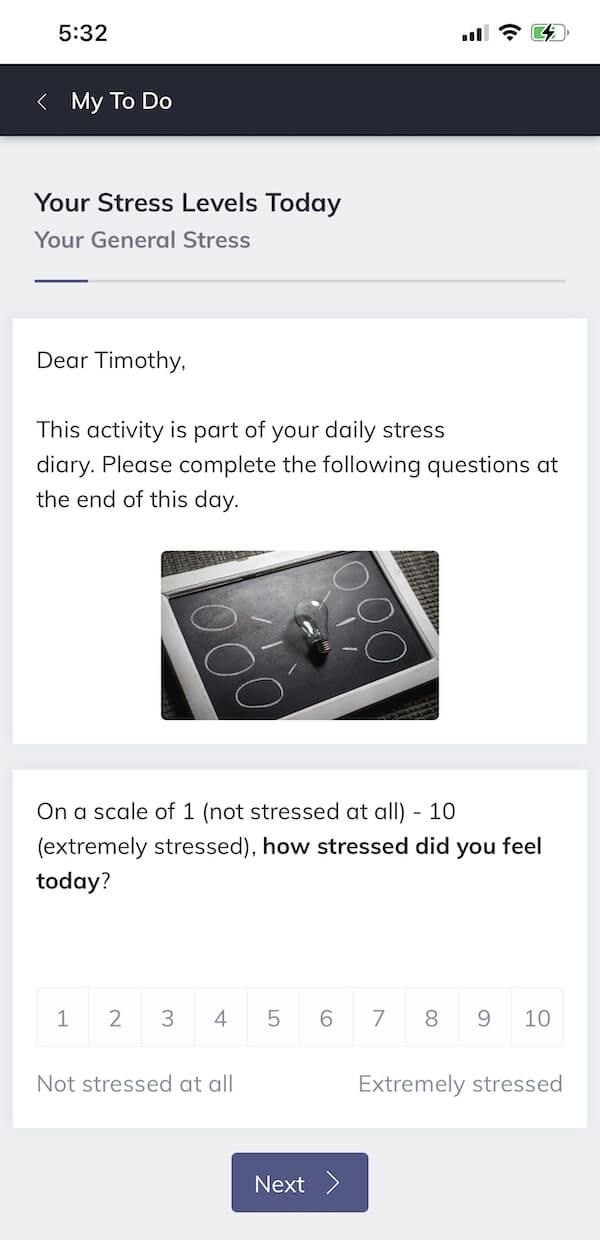
Despite the dangers of experiencing prolonged stress, many of us are likely to be tuned out to our body’s signals that we are experiencing stress.
Likewise, we may not have stopped to consider the factors in our lives that are most responsible for causing us stress.
To help strengthen your clients’ awareness of the drivers and experience of stress, consider inviting them to complete a one-week stress diary.
The purpose of a stress diary is to help them look for patterns and insights into the most common causes of stress in their life and their reactions to stressful events. From here, you can help your clients find effective ways of dealing with stress in the future.
For a great, easy-to-administer tool, consider taking a look at the Stress Diary tool available via the blended care app Quenza .
The platform features a growing library of pre-programmed psychoeducational activities, within which is the Stress Diary Pathway. This pathway invites clients to reflect on the day’s stressful experiences for eight days and culminates in an in-depth reflection into the patterns of stressors, as well as the client’s reactions to these across the eight days.
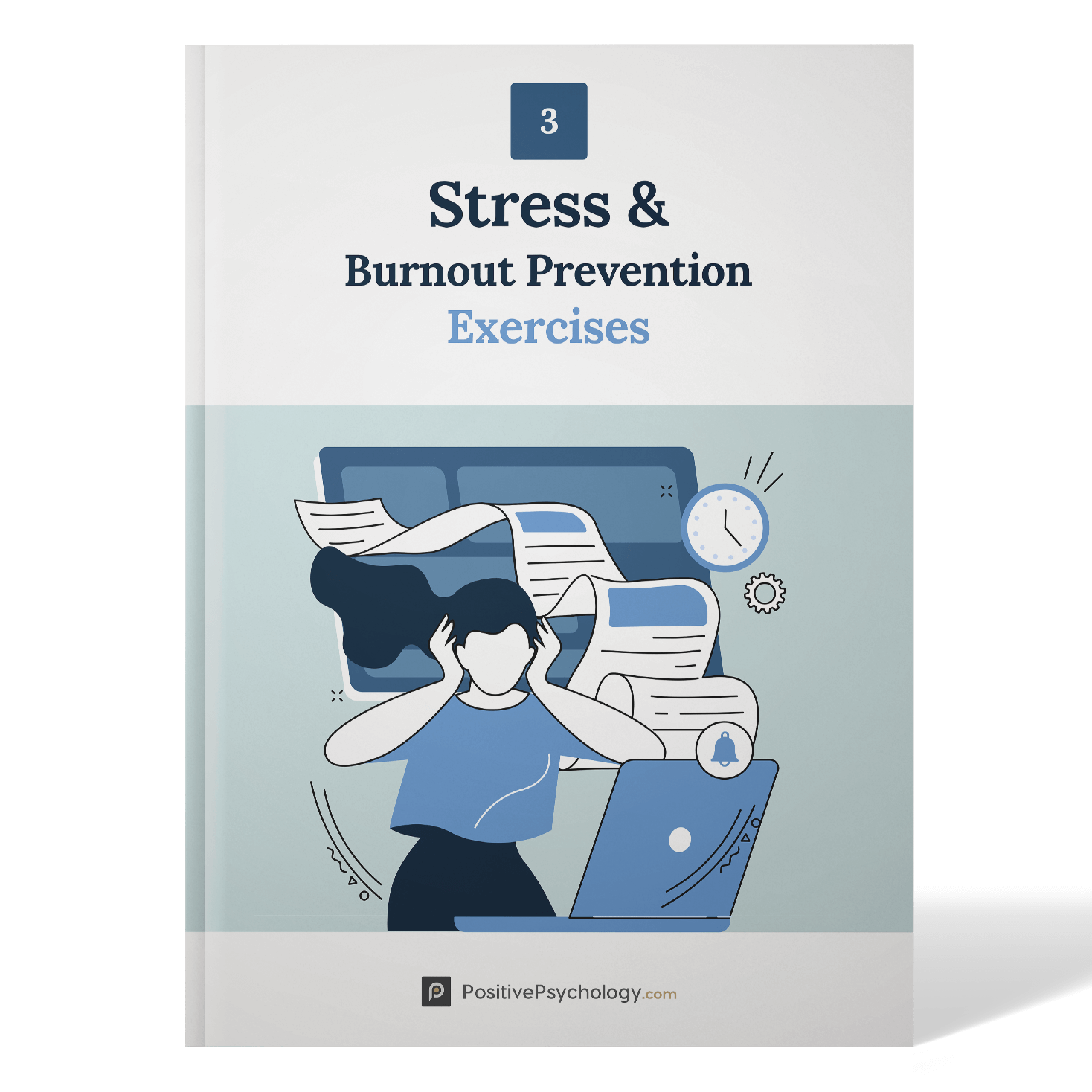
Download 3 Free Stress & Burnout Prevention Exercises (PDF)
These detailed, science-based exercises will equip you or your clients with tools to manage stress better and find a healthier balance in their life.
Download 3 Stress & Burnout Prevention Exercises Pack (PDF)
By filling out your name and email address below.
- Email Address *
- Your Expertise * Your expertise Therapy Coaching Education Counseling Business Healthcare Other
- Name This field is for validation purposes and should be left unchanged.
A 2019 report found that in the UK alone, 12.8 million working days were lost due to stress, depression, and anxiety.
But help is at hand.
Multiple, evidence-based stress reduction techniques have been shown to lower stress levels, “ resulting in a reduction of disease symptoms, lowering of biological indicators of disease, prevention of disease and improvement of patient’s quality of life ” (Varvogli & Darviri, 2011).
Many of these techniques are described below and will help you to manage stress in your life.
1. Breath Awareness
Breathing exercises can be a powerful way to place your body in a relaxed state. Sitting in a comfortable position and drawing your attention to your breath can release tension and offer a method for ongoing relaxation and a tool to use for times of stress.
Breath Awareness was created to help individuals cultivate a mindful awareness of their breathing and the present moment rather than get caught up in their thoughts.
Once comfortable, clients are asked to release any unnecessary tension and tune in to their breath. They are invited to observe the movements and sensations in their body with each inhale and exhale, without trying to change anything.
The exercise can be useful during moments of distress to unhook someone from their thoughts or as a mindfulness exercise.
Try out the Breath Awareness worksheet and practice it daily.
2. Anchor Breathing
Similar to the last activity, anchor breathing involves inhaling and exhaling consciously while focusing on the physical experience. In this exercise, clients are also instructed to imagine a peaceful scene – being on a boat, feeling calm and safe.
Deep breathing techniques have been shown to lead to decreased oxygen consumption and heightened alertness. EEG recordings have also recorded increases in theta wave amplitude when participants engage in certain deep breathing exercises, which is associated with reduced symptoms of generalized anxiety disorder (Jerath, Edry, Barnes, & Jerath, 2006).
By showing patients how combine mindful breathing with calming, peaceful visualization, Anchor Breathing provides an effective relaxation technique, reducing residual stress levels and providing support during acute episodes of stress (Varvogli & Darviri, 2011).
3. The Five Senses Worksheet
Mindfulness can be cultivated by paying attention to what we observe and feel while using our different senses one at a time. During mindfulness practice, distractions are observed, and attention is gently returned to the body part receiving focus.
This exercise works in a similar way to the Body Scan exercise, which helps clients cultivate a mindful awareness of different body parts. Evidence from functional magnetic resonance imagining found that body scan meditation heightens brain activity linked to increased awareness of the present moment, focus, and stress reduction (Sevinc et al., 2018).
To read more about the steps involved, you can view or download The Five Senses worksheet .
If you’re looking for more tools, our free Mindfulness Exercises Pack includes the popular Leaves on a Stream tool and audio meditation, as well as two other mindfulness tools and audio files that you can download for free.

1. Nature effect
The powerful effect of being outdoors has been validated many times and should not be underestimated.
Visitors to a park in Zurich were found to have significantly lower levels of stress, a reduced number of headaches, and a 40% increase in feelings of wellbeing. These positive effects were further elevated in those taking part in sports (Hansmann, Hug, & Seeland, 2007).
While drugs and therapy are often used as treatments for soldiers returning home with post-traumatic stress disorder, the medications and treatment frequently have to be continued for many years without providing a lasting cure. In response, nature-based therapy has begun to receive increased scientific attention.
In a 2016 study, veterans reported that merely being in the garden, often performing mindfulness activities, could improve the symptoms of their post-traumatic stress disorder (Poulsen, Stigsdotter, Djernis, & Sidenius, 2016).
The simple act of getting out into an open space can provide stress relief. We delve deeper into this in our post on Environmental Psychology .
2. Exercise
We are all aware of the physiological rewards of exercise, but the psychological benefits are equally impressive and backed up by research.
A seven-week exercise program was found to improve people’s moods ; reduce perceived stress; and increase optimism, self-belief , resilience, and a growth mindset (Cassidy, 2016).
Exercise regimes need not be extreme to be effective. Even modest levels of physical activity if performed regularly provide ongoing support for mental wellbeing, a growth mindset, and reduced levels of stress.
A great way to inspire you to start exercising may be found in our article on Mindful Running and Exercises .
3. Mindful movement
By replacing or combining some of our everyday car journeys with walking, we can become fully present in our day-to-day lives and improve mental health.
Indeed, a trial in 2017 found that combining walking with relaxation techniques is a great way to reduce levels of stress (Matzer, Nagele, Lerch, Vajda, & Fazekas, 2017).
Mindful walking combines the benefits of exercise, nature, and mindfulness.
Its goal is not to reach a destination, but to build an awareness of the moment, using the feet to anchor in the present. Pleasant and unpleasant bodily sensations such as muscle soreness are merely observed without opinion and let go.
3-Minute stress management: reduce stress with this short activity – Therapy in a Nutshell
Many people seek help when stress makes healthy living difficult. Therapy can help address immediate difficulties and work on the underlying causes (Strauss et al., 2018).
1. Anxiety Record
We often feel more vulnerable when we are asked to share what is making us anxious. The Anxiety Record worksheet helps individuals to understand what is causing their anxiety and learn appropriate coping skills.
Using this worksheet, clients can record their anxieties, triggers, and their effects. Afterward, they are guided through a breathing exercise and asked to revisit their answers to the questions.
A few prompts from this exercise are listed below:
- When do you feel anxious?
- What thoughts are you having before or during feeling anxious?
- Do you think these thoughts are realistic?
- What thoughts could you replace them with?
Click to download the Anxiety Record worksheet and give it a try.
2. Biofeedback training
Biofeedback builds on the concept of homeostasis introduced earlier. Using technology to measure and report brainwaves, skin temperature, breathing, and heart rate, the individual learns how to gain self-control over apparently involuntary bodily functions.
A recent meta-analysis of 24 studies confirmed that biofeedback training led to improvements in coping and offers a promising approach for treating stress and anxiety (Goessl, Curtiss, & Hofmann, 2017).
Individuals can ultimately learn to control their heart rate and blood pressure, reduce levels of stress, and even successfully treat high blood pressure and cardiac disease. Performed with a qualified therapist, these changes ultimately persist beyond the therapy (Varvogli & Darviri, 2011).
Worksheet Suggestions for Your CBT Sessions

Many of us experience spontaneous thoughts as images rather than individual words or an internal conversation (Beck & Beck, 2011).
A child pictures an angry parent, and an employee imagines a demanding boss. They can be powerful, representing moments of fear or anxiety, and can be used in Cognitive-Behavioral Therapy (CBT) sessions.
The following questions can form the basis of a conversation to explore a mental image and the individual’s relationship with it, cognitively restructuring its interpretation.
Imagery can feel as real to the mind as being in the situation, so playing through images in advance can restructure thoughts and emotions and reframe the stress.
2. Daily Exceptions Journal
A journal can be a fruitful way to track life’s ups and downs. Positive CBT encourages monitoring the client’s strengths and the positive outcomes of life rather than focusing on the negatives.
By capturing what went well in a Daily Exceptions Journal, it is possible to identify and record the skills and talents for reuse in other areas of your life.
Subsequently, walking through the journal during therapy reinforces successes, provides praise, and encourages discussion of the problems overcome.
Sensory awareness involves paying attention to a specific sensory aspect of the body. It can be a great way to teach mindfulness to children.
Such activities can also improve focus, increase self-awareness , help regulate emotions , and reduce anxiety.
1. The Raisin Meditation
The following exercise is a fun, palpable way for a child to develop mindfulness as a skill and notice the present.
Work through the Raisin Meditation worksheet following the steps with the child, paying attention to each sense in turn.
Children paying increased attention to their senses can learn to improve their focus and feel calmer.
2. Nature Play
Ongoing research has recognized the importance of playing and spending time outdoors on children’s mental wellbeing (Dankiw, Tsiros, Baldock, & Kumar, 2020).
Practicing underused senses such as sound can heighten a sense of awareness and promote mindfulness. This can be especially true in an unfamiliar environment, including walking through the countryside with family.
The questions can be tailored to the environment. Starting or pausing somewhere relatively quiet may assist the child’s focus more at the start.
Print the Nature Play worksheet here.
3. Anchor Breathing
Anchor breathing can be quickly learned and helps a child to focus their mind on one point.
Such mental training offers a valuable method for gaining perceived self-control and reducing stress.
The Anchor Breathing method also works with hands placed gently on the belly or in front of the nose.

The following three examples, along with the activities described above, can be learned quickly and implemented into a student’s daily routine to help manage both acute and chronic stress.
1. Urge Surfing
Coping with (often self-destructive) urges can be difficult, especially in times of stress. Such behavior can become a crutch, making us feel like we are taking control, when in reality, we are relinquishing it.
The Urge Surfing worksheet is available with a subscription to the Positive Psychology Toolkit© . Backed up by scientific research, mindful self-acceptance can teach individuals to observe their cravings rather than act upon them.
2. Meditation on the Soles of the Feet
Meditation on the Soles of the Feet provides a safe space to work on managing strong emotions and regulating the urge to be aggressive , often a byproduct of stressful situations (Kruk, Halász, Meelis, & Haller, 2004).
The individual is not asked to stop angry thoughts – anger does serve a useful purpose at times – but rather to bring them under control through a shift of focus.
The client, standing or sitting with their feet on the ground, is asked to cast their mind back to a time that caused them to react very angrily. Then they are told to stick with those angry thoughts, letting them flow without hindrance. After that, they shift their attention to the soles of their feet.
Stretching and moving their toes, they feel the texture of their socks, the surface of the ground, or the insole in their shoes. They maintain focus, breathing naturally until feeling calm and in control.
Learning to manage anger more effectively reduces stress and anxiety, and increases feelings of control.
The full exercise is accessible with a subscription to the Positive Psychology Toolkit© .
3. Mindfulness
Working through the Leaves on a Stream and anchor breathing techniques, which are part of our free Mindfulness Exercises Pack , will help students focus awareness on the present moment and acknowledge and accept their feelings, thoughts, and emotions.
Research has identified the benefits of combining mindfulness and group therapy to help manage stress and increase resilience and positivity (Seyyed Moharrami, Pashib, Tatari, & Mohammadi; Babakhani, 2017).
Here is an example of a group exercise in mindfulness.
Walking Down the Street
The ability to observe, rather than react to, thoughts, emotions, and sensations is central to positive psychology.
The challenge is that the event and our thoughts about it are far from being the same.
The steps involved in the following exercise can be performed individually or in a group exercise, where everyone benefits from hearing one another’s thoughts.
Walking through the scene and discussing it in the group can help to develop positive behavioral change by separating thoughts and feelings from impulses and actions and, importantly, shape feelings while breaking a negative cycle of thinking.
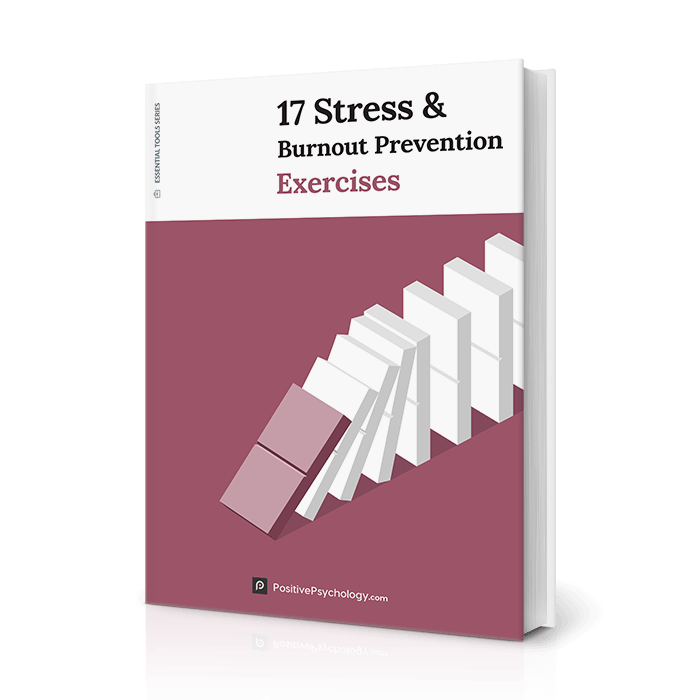

17 Exercises To Reduce Stress & Burnout
Help your clients prevent burnout, handle stressors, and achieve a healthy, sustainable work-life balance with these 17 Stress & Burnout Prevention Exercises [PDF].
Created by Experts. 100% Science-based.
Resources from PositivePsychology.com
Building resilience helps clients bounce back from stressful situations and use coping mechanisms to turn them into opportunities for growth.
The Realizing Resilience Masterclass© provides guidance, along with a set of practical tools, to build a more resilient mindset.
If you’re looking for more science-based ways to help others manage stress without spending hours on research and session prep, this collection contains 17 validated stress management tools for practitioners. Use them to help others identify signs of burnout and create more balance in their lives.
Stress does not have to rule us. Stress should not be allowed to prevent us from doing what we want or need to do.
Instead, stress should be an enabler and drive us forward to build what we want and take on challenges that will allow us to grow.
There should be no excuse to hide from stress or become overwhelmed by it.
By using tools for coping and taking control, we can see stress as something natural that can invigorate and motivate us to overcome both planned and unexpected challenges.
These activities we shared will definitely help you manage stress. However, there are many other stress-management techniques to try out too. Identify those that work for you and implement them into your life. You will reap the benefits, especially before the next job interview or presentation.
Thank you for reading!
We hope you enjoyed reading this article. Don’t forget to download our three Stress & Burnout Prevention Exercises (PDF) for free .
- Arch, J. J., & Mitchell, J. L. (2015). An Acceptance and Commitment Therapy (ACT) group intervention for cancer survivors experiencing anxiety at re-entry. Psycho-Oncology, 25 (5), 610–615.
- Beck, J., & Beck, A. (2011). Cognitive behavior therapy: Basics and beyond. Guilford Press.
- Bergstrom, C. (2018). Ultimate mindfulness activity book: 150 mindfulness activities for kids and teens (and grown-ups too!). Blissful Kids.
- Babakhani, K. (2017). The effectiveness of cognitive-behavioral therapy group on self-efficacy and quality of life of women with breast cancer. Multidisciplinary Cancer Investigation , 1 (1).
- Brosschot, J. F., Verkuil, B., & Thayer, J. F. (2016). The default response to uncertainty and the importance of perceived safety in anxiety and stress: An evolution-theoretical perspective. Journal of Anxiety Disorders, 41 , 22–34.
- Cassidy, T. (2016). Psychological benefits of adhering to a programme of aerobic exercise. Clinical and Experimental Psychology, 2 (2).
- Dankiw, K. A., Tsiros, M. D., Baldock, K. L., & Kumar, S. (2020). The impacts of unstructured nature play on health in early childhood development: A systematic review. PLoS One, 15 (2).
- De Vibe, M., Solhaug, I., Tyssen, R., Friborg, O., Rosenvinge, J. H., Sørlie, T., & Bjørndal, A. (2013). Mindfulness training for stress management: A randomized controlled study of medical and psychology students. BMC Medical Education, 13 (107).
- Goessl, V. C., Curtiss, J. E., & Hofmann, S. G. (2017). The effect of heart rate variability biofeedback training on stress and anxiety: A meta-analysis. Psychological Medicine, 47 (15), 2578–2586.
- Hansmann, R., Hug, S., & Seeland, K. (2007). Restoration and stress relief through physical activities in forests and parks. Urban Forestry & Urban Greening, 6 (4), 213–225.
- Jerath, R., Edry, J. W., Barnes, V. A., & Jerath V. (2006). Physiology of long pranayamic breathing: Neural respiratory elements may provide a mechanism that explains how slow deep breathing shifts the autonomic nervous system. Medical Hypotheses , 67 (3), 566–571.
- Kruk, M. R., Halász, J., Meelis, W., & Haller, J. (2004). Fast positive feedback between the adrenocortical stress response and a brain mechanism involved in aggressive behavior. Behavioral Neuroscience, 118 (5), 1062–1070.
- Lee, C. S., Park, S. U., & Hwang, Y. K. (2016). The structural relationship between mother’s parenting stress and child’s wellbeing: The mediating effects of mother’s growth mindset and hope. Indian Journal of Science and Technology, 9 (36).
- Matzer, F., Nagele, E., Lerch, N., Vajda, C., & Fazekas, C. (2017). Combining walking and relaxation for stress reduction: A randomized cross-over trial in healthy adults. Stress and Health , 34 (2), 266–27.
- Poulsen, D. V., Stigsdotter, U. K., Djernis, D., & Sidenius, U. (2016). ‘Everything just seems much more right in nature’: How veterans with post-traumatic stress disorder experience nature-based activities in a forest therapy garden. Health Psychology Open, 3 (1).
- Sevinc, G., Hölzel, B. K., Hashmi, J., Greenberg, J., McCallister, A., Treadway, M., … Lazar, S. W. (2018). Common and dissociable neural activity after mindfulness-based stress reduction and relaxation response programs. Psychosomatic Medicine , 80 (5), 439–451.
- Seyyed Moharrami, I., Pashib, M., Tatari, M., & Mohammadi, S. (2017). The efficiency of stress management group therapy in job stress and self-efficacy of nurses. Journal of Torbat Heydariyeh University of Medical Sciences, 5 (1), 42–49
- Strauss, C., Gu, J., Pitman, N., Chapman, C., Kuyken, W., & Whittington, A. (2018). Evaluation of mindfulness-based cognitive therapy for life and a cognitive behavioral therapy stress-management workshop to improve healthcare staff stress: Study protocol for two randomized controlled trials. Trials , 19 (209).
- Varvogli, L. & Darviri, C. (2011). Stress management techniques: Evidence-based procedures that reduce stress and promote health. Health Science Journal , 5 , 74–89.
Share this article:
Article feedback
What our readers think.
The resources was very helpful. thanks.
Interesting article although I wasn‘t able to open the links as it sent me to a site saying I had to purchase a toolkit in order to access them! I don‘t know why I get sent emails with resources that I‘m unable to access. Shame!
Glad you found the article interesting, and I’m sorry our distinction between the free and paid resources here is not as clear as it could be — I’ll flag this with our editor. Yes, some of the resources listed are freely available while others are available to subscribers of the Positive Psychology Toolkit . However, the three resilience exercises mentioned at the beginning are free and should instantly arrive in your inbox and be available to use.
– Nicole | Community Manager
These will be most helpful with the Native American population I serve
Very practical exercises of relaxation. True we have to rule ourselves not left to unnecessary stress which consequently results in low well being and reduce quality of life. Thank you Jeremy
Very helpful and easy to understand and practice documents. Grateful.
The article was more helpful and am looking forward to read more of this kind.
Hi Moses, So glad you found the resources helpful. Another great tool for dealing with stress is journaling, which you can read up about in our dedicated article here. – Nicole | Community Manager
Let us know your thoughts Cancel reply
Your email address will not be published.
Save my name, email, and website in this browser for the next time I comment.
Related articles

Overcome Languishing & Flourish: A Positive Psychology Guide
Amidst the turmoil of the recent pandemic, one positive psychology construct has captured more attention than any other. As societies worldwide had to endure lockdowns [...]

7 Trauma Response Types & How to Recognize Them
Over-sharing. Over-explaining. Trauma dumping. Hyperindependence. Hypersexualization. People pleasing. Do these sound like common traits your clients have? These may not be character traits but, instead, [...]

6 Best Diaphragmatic Breathing Exercises to Reduce Anxiety
Our brain controls our breathing largely without conscious awareness. We shower, watch football, listen to music, and sleep while our respiratory system functions in the [...]
Read other articles by their category
- Body & Brain (48)
- Coaching & Application (57)
- Compassion (26)
- Counseling (51)
- Emotional Intelligence (24)
- Gratitude (18)
- Grief & Bereavement (21)
- Happiness & SWB (40)
- Meaning & Values (26)
- Meditation (20)
- Mindfulness (45)
- Motivation & Goals (45)
- Optimism & Mindset (34)
- Positive CBT (28)
- Positive Communication (20)
- Positive Education (47)
- Positive Emotions (32)
- Positive Leadership (17)
- Positive Parenting (3)
- Positive Psychology (33)
- Positive Workplace (37)
- Productivity (16)
- Relationships (46)
- Resilience & Coping (36)
- Self Awareness (21)
- Self Esteem (37)
- Strengths & Virtues (31)
- Stress & Burnout Prevention (34)
- Theory & Books (46)
- Therapy Exercises (37)
- Types of Therapy (64)

- Comments This field is for validation purposes and should be left unchanged.
3 Stress Exercises Pack
stress powerpoint
All Formats
Resource types, all resource types.
- Rating Count
- Price (Ascending)
- Price (Descending)
- Most Recent
Stress powerpoint
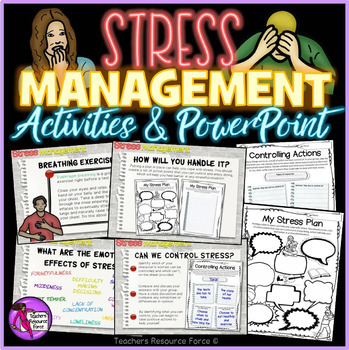
Stress Management: Activities and PowerPoint for teens

Fight-Flight-Freeze Response / Managing Stress / Digital Google Slides ™

- Google Apps™

Stress Management Google Slides Digital Lesson

- Google Slides™
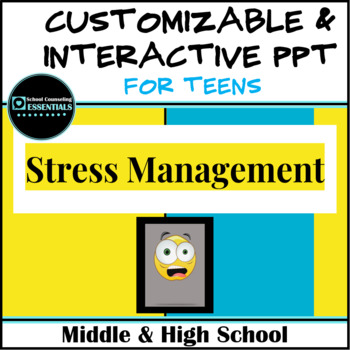
Stress Management PowerPoint - Customizable- Low Prep!! - Middle & High School

Stress Management PowerPoint and Activities for Teens | Coping Skills

Chair Yoga Activity for Google Slides : Improve Focus & Reduce Stress | SEL

Avoid Thinking Traps and Worries / Managing Stress / Digital Google Slides ™
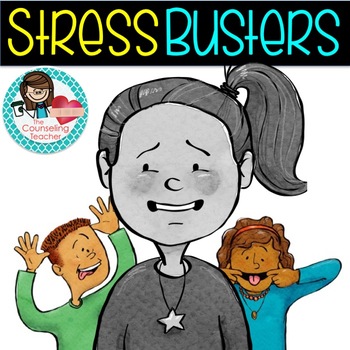
Stress Management Powerpoint

Life Skills: Stress Management Strategies PowerPoint Presentation

Coping Strategies Lessons / Managing Stress / Digital Google Slides ™
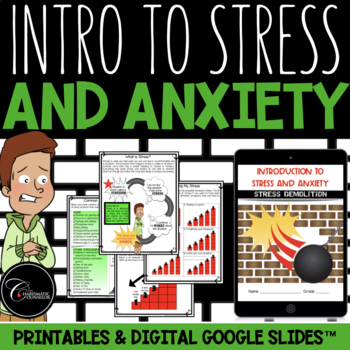
Introduction To Stress and Anxiety / Managing Stress / Digital Google Slides ™
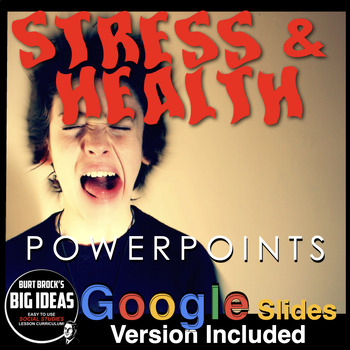
Psychology: Stress & Health PowerPoints /Google Slides + Speaker and Guided Notes

Challenge Negative Thoughts / Managing Stress / Google Slides ™

Word Stress Pronunciation & Speaking Fluency Activities and PowerPoints BUNDLE

Homographs to Teach Stress and Schwa - on Google Slides

Toolkit Solutions for Teens: Navigating Academic Stress PPT

Stress and Anxiety Management Lesson Plan & Powerpoint

Stress Presentation for Kids | Google Slide Link | PDF | Mental Health | SEL

Facing Stress & Anxiety Monster: PowerPoint on Building Resiliency

Energy & Stress Management Unit: 10 lessons with PPT and student journals

Psychology: Conflict, Stress & Coping ~ Engaging, Analytic PPT Slide Deck

Stress PowerPoint Presentation Lesson Plan

Don't Stress ! It's Just a Test! ( PowerPoint )

Stress Management Toolkit: Comprehensive PowerPoint and Handout Guide

- We're hiring
- Help & FAQ
- Privacy policy
- Student privacy
- Terms of service
- Tell us what you think

Unit Plan- Stress Management
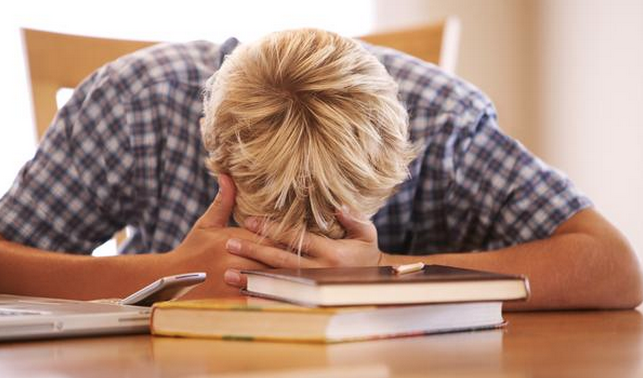
- June 26, 2015
This post originally appeared on Choices.Scholastic.com
It’s crunch time! Stress management for teens.
May is a stressful time to be at school. Younger kids are finishing up projects, older ones are gearing up for finals, and most of us teachers are left wondering how it will all get graded in time.
As adults, we know what can happen if we’re not dealing well with stress. Eating, procrastination, yelling, blaming, even binge watching TV… we all have unhealthy coping skills that we need to be aware of. Same goes for the kids. Now is a great time for a lesson (or a refresher) on stress.
Here are some ideas for middle school that could work for high school as well.
Day 1: What is stress?
Intro activity:
To encourage mindfulness, we want our students to recognize the physiological signs of stress. We do this by setting up a very high-pressure/low-stakes activity, like a cup-stacking tournament. Single elimination, very little practice, totally unfair.
By the time we get to the final round, kids are jumping up and down and are in full fight-or-flight mode. This is an idea I inherited from the teacher before me, and it does a great job getting the kids to experience stress with little chance of lasting humiliation.
If you don’t have sets of cups, a card game like War will do. The important thing is to put the brackets on the board, get the eraser out, and act like it’s the most important thing in the world.
Afterwards, I have the kids share what they were experiencing physically during the competition. Shaky hands, rapid heartbeat, butterflies, sweaty palms…
By the time we’re done chatting they’ve all calmed down and have mostly forgotten about the tournament. It’s a great chance to remind them that just because something doesn’t matter long-term, it doesn’t mean our stress responses change.
For example, how did you feel the last time you thought you lost your phone?
Day 2: Why do we experience stress? How does it affect me personally?
This is when we get into the nitty-gritty of stress; the key vocabulary, the fight-or-flight response, and some of the stressors that they experience as middle school students.
Here are some of the resources that we use:
The counselors! Ours pop by for a lesson on stress and as a reminder that they’re there if needed.
For younger students, Brain Pop: Stress is a great intro video and comes with resources, online quizzes and other materials. If your school doesn’t have a subscription, there are free resources available on KidsHealth.org .
If you’re looking for a book or more activities, try The Stress Reduction Workbook for Teens: Mindfulness Skills to Help You Deal with Stress .
And if you haven’t seen it yet, I highly recommend Kelly McGonigal’s TED Talk, How to make stress your friend . It’s a must watch for any health class, grades 6-12.
“Chasing meaning is better for your health than trying to avoid discomfort.” – Kelly McGonigal. LOVE THIS.
Which leads us right into the next lesson.
Day 3: Coping Skills
Journal: What are some of the healthy ways you deal with stress? What are some of the not so healthy ones? Be honest!
So many of the risk behaviors we try to protect our kids from – alcohol, drugs, bullying, food issues– are all unhealthy ways of dealing with stress. The secret is to find some healthy coping skills before the unhealthy ones have a chance to set in.
We brainstorm a list of as many as we can on the board – meditation, journaling, hanging with friends, talking to your mom, watching YouTube videos of cats falling down (within moderation of course!) – and the kids jot down their top five.
Then after watching this awesome video from Berna and Team Choices, they get to work on creating a similar video of their own.
Instruction sheet and rubric: Stress Buster Video Rubric
If you don’t have time for a big project, this could easily be adapted into a poster, a presentation, or something else a little quicker.
Now stop surfing the Internet and get back to that pile of work…
New Blog Posts
Health activities for the last few days of school, alcohol & drug research lab- 2022, resources for home learning during coronavirus, vaping advocacy activity, the latest on vaping and e-cigarettes…., evaluating websites, earcos etc 2019, great video to show teens about juuls, 8th grade tech balance, health sites web quest, npr podcast- the reading brain in the digital world, analyzing the scientific evidence behind health news, more hints and tips in the classroom....

Ideas for Family Fun
Image: Shanghai Daily In our ever connected world, we sometimes forget to connect with those we’re closest to! For our 8th grade Family Advocacy project,

Puberty Help for Parents
We’ve just finished up with our puberty unit for the 6th graders, and oftentimes, it’s more stressful for the parents than it is for the kids.

Health Class Summer School Survival Kit
This post originally appeared on Choices.Scholastic.com My first experience as a health teacher was during summer school. I was only 24 years old, at the

Tech Tips for Parents
When it comes to balancing your family’s digital diet, there are a ton of great resources out there for parents. I always recommend starting with

The Energy Bar Project: Part 2
Last week I wrote about part one of a new project my 8th graders have been working on where they analyze the health claims of
Get Updates And Stay Connected
Subscribe to the health teacher newsletter, contact information.
All rights reserved, unless otherwise stated.
- Preferences

Stress Management in Students - PowerPoint PPT Presentation
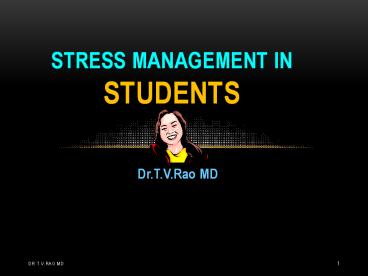
Stress Management in Students
Stress management in students – powerpoint ppt presentation.
- Dr.T.V.Rao MD
- The best years of your life? Expectations..
- Even positive change is stressful
- Greater academic demands
- Unstructured time
- Decreased adult availability
- Being on your own in a new environment
- Changing relations with family
- Alcohol and other drugs
- Sex-identity, values, practices
- Balancing Academic and Extracurricular
- GENERAL Life management skills, for the purposes of this section, include stress management, time management, information management, financial management, personal health management, and crisis management. Personal planning and adeptness at managing each of these issues will increase the serenity and reduce the stressors within a busy, productive life.
- Personal planning and adeptness at managing each of issues will increase the serenity and reduce the stressors within a busy, productive life.
- Every human on the earth will experience stress, even medical students and physicians--it is a common denominator in life. Some stress is good stress (eustress) that is helpful and assists the drive toward achievement and success. Negative stress (distress) affects life in an adverse manner and is a common cause of ill health in our society. Individuals who ignore stress signals or who cope in a negative fashion will experience escalating symptoms of stress. The symptoms may appear as burnout, exhaustion, emotional illnesses such as depression and anxiety, and physical illnesses such as ulcers, heart attacks, hypertension, and abuse of alcohol and other drugs with all the social and professional consequences.
- Stress is your mind and bodys response or reaction to a real or imagined threat, event or change.
- The threat, event or change are commonly called stressors. Stressors can be internal (thoughts, beliefs, attitudes or external (loss, tragedy, change).
- Teens are under more stress
- Since adolescence is a period of significant changes
- social, and
- academic changes
- many than at any other time of life.
- It's important to remember that stress is a natural part of life. Experiencing stress can be good, but it can also have negative effects on one's well being. What makes stress a positive or negative factor lies with how effectively the person experiencing the stress is able to manage it.
- Medical education has deleterious consequences. Trainees (students, interns, and residents) suffer high levels of stress, which lead to alcohol and drug abuse, interpersonal relationship difficulties depression and anxiety, and even suicide. Medical students have mean anxiety scores one standard deviation above those of non-patients, and their depression levels increase significantly
- Poor appetite or overeating
- Feeing tired and fatigued
- Various aches and pains ---headache body ache muscle pain
- Nausea abdominal Pain
- Sleep problems
- Falling sick very often e.g. fever cough cold diarrhea
- ( because of lowering of immunity due to stress)
- Feeling low
- Nervousness and Anxiety
- Excessive Anger or Depression
- Being easily upset
- Poor self confidence
- Low self esteem
- Lack of Concentration
- Poor performance in studies
- As a way of draining off stress energy, nothing beats aerobic exercise. To understand why, we need to review what stress is. People often think of stress as pressure at work, a demanding boss, a sick child or rush-hour traffic. All these may be triggers but stress is actually the body's reaction to factors such as these. Stress is the fight-or-flight response in the body, mediated by adrenaline and other stress hormones, and comprised of such physiologic changes as increased heart rate and blood pressure, faster breathing, muscle tension, dilated pupils, dry mouth and increased blood sugar. In other words, stress is the state of increased arousal necessary for an organism to defend itself at a time of danger.
- Eustress or positive stress occurs when your level of stress is high enough to motivate you to move into action to get things accomplished.
- Distress or negative stress occurs when your level of stress is either too high or too low and your body and/or mind begin to respond negatively to the stressors.
- As you begin to experience a stressful event or perceive something to be stressful psychological changes occur in your body. This experience or perception disrupts your bodys normal balance and immediately your body begins to respond to the stressor(s) as effectively as possible.
- Most people who need care dont seek it or receive it
- Stigma, cultural pressure, mistrust, lack of information keep people out of care
- So do lack of resources treatment and medication are expensive
- Care is disjointed
- Some schools dont see emotional well-being and growth as in their mission
- Relationship problems
- Eating Disorders
- Substance Abuse
- Sleep Problems
- Situational
- Developmental
- Generalized anxiety disorder
- Performance
- Panic disorder, OCD, phobias
- 35 of adult population experience insomnia
- 11 of college students get a good nights sleep
- Loss of cognitive functioning, driving
- Increased risk of depression
- lt 7 hours yields sleep deprivation
- Making little changes in your life can really add up to a big feeling of relief.
- Learn to recognize when you are feeling stressed and simple ways you can relax.
- Take a break. Have a cold drink, get some fresh air, or close your eyes for a minute to refocus.
- Stay positive to help friends and family cope with stress.
- Let others know you're feeling overwhelmed and tell them how they can help.
- Allow yourself to simply say "no" to friends and family when you know you cannot meet their demands without becoming overwhelmed.
- Can you change your stressors by avoiding or eliminating them?
- Can you reduce their intensity (manage them over time instead of immediately)
- Can you shorten your exposure to stress (take a break, leave)
- Can you devote the
- time necessary to make
- Greeks home of the comediane
- Native Americans Clown Doctors
- The Art of Medicine consists of amusing the patient while nature cures the disease.
- Medicine today?
- An attitude toward life.
- Taking your work seriously but yourself lightly.
- Humor is healthy.
- Humor connects us to others!
- It makes us MORE effective!
- Humor is a wonderful stress reducer, an antidote to upsets. Laughter relieves tension. In fact, we often laugh hardest when we have been feeling most tense.
- Humor is an individual thing - what is funny to one individual may be hurtful to another. It is wonderful when patients can poke fun at themselves. We can also do this with patients, but we have to be careful and respectful in what we say. If you think of something funny that may help the patient, say it if you feel it will ease their tension and not be offensive. I will often throw in a quip or joke when I think it is appropriate. When it is done sensitively, laughter is a great gift to people you care about.
- Gather Data
- Provide Rapid Access to Care
- Offer Education and Outreach
- Involve Students
- Coordinate Care
- Be aware of community resources
- Understand your limits
- Documentation
- How busy is counseling? Identify patterns and peak times of use.
- Where else do students get care?
- How many students take time off for medical reasons? Who comes back?
- How many students are hospitalized?
- Be known. Get out in the community.
- Train residence staff to recognize warning signs of common problems.
- Serve as liaisons/consultants to residence staff, deans, coaches.
- Supervise student groups peer counselors, wellness reps, advocacy groups
- Offer for-credit course to freshmen on stress and time management
- Start a Wellness Center on campus
- Focus on prevention Eat, Sleep, Exercise
- Engage Students in community- study breaks, hikes, massage
- Teach yoga, sleep hygiene, relaxation response as part of leading balanced life.
- Have annual wellness or caring events or maximize academic potential, minimize stress
- Student Wellness Reps.
- Practice time management
- Learn relaxation exercises.
- Rehearse and practice situations.
- Learn practical coping skills.
- Decrease negative self talk.
- Learn to feel good with a workable result Dont be a perfectionist.
- Build a network of friends.
- Ultimately, the only people who can get through to students with any consistency are the students themselves Peer Counseling/ Education Programs
- Student Health Advisory Group
- Wellness representatives in the dorms
- Mental Health Advocacy Group
- Involve in screenings and education
- Legal issues
- Confidentiality
- What about parents?
- How much care for whom? How are sickest students cared for?
- When should students take a medical leave of absence? Re-entry?
- Orient them and make them partners
- Dont say I cant talk to you.
- Process of communication is key dont shut them out
- Invite them to get permission
- Discuss general concerns, suggestions without breaching confidentiality
- Balancing needs of individual and community
- Balancing care and education
- How are sickest students cared for?
- When should students take a medical leave of absence?
- Emotional and physical well-being are crucial for academic success
- The entire student body benefits from a strong counseling program
- The institution benefits by increased retention and graduation, which enhance reputation
- Get plenty of exercise and sleep. Improved focus and concentration help increase efficiency, so you can complete tasks in less time.
- Even during their medical colleges careers, many students take on extracurricular activities and projects that are not covered at medical colleges.
- Extracurricular activates reduces the stress level
- Develop mutually supportive friendships/relationsh ips.
- Pursue realistic goals which are meaningful to you, rather than goals other have for you that you do not share.
- Expect some frustrations, failures and sorrows.
- Always be kind and gentle with yourself be a friend to yourself.
- Be prepared for unexpected problems such as traffic, a lost pet or a family emergency.
- Prioritize. Take control of your "to do" list by deciding what's really most important on your list.
- Write down feelings of sadness, frustration or anger to get a clearer perspective of your emotions.
- Enjoy life's simple pleasures like colorful flowers, dancing, music, and social outings, etc.
- Share your talents to better the lives of others as well as your sense of well-being.
- STRESS is very common
- Use stress in a positive way
- Limit NOT eliminate stress.
- Use it to improve your performance.
- Learn Coping Skills
- Academic performance is enhanced by physical and emotional health
- We can learn to recognize problems much earlier
- Depression, Anxiety and Stress are treatable
- Education, Psychotherapy and Medication are all effective
- Self Care--eat, sleep, exercise--is a cornerstone of health (for all of us!)
- Being in control of your life and having realistic expectations about your day-to-day challenges are the keys to stress management, which is perhaps the most important ingredient to living a happy, healthy and rewarding life.
- Marilu Henner
- The programme created by Dr.T.V.Rao MD for Students in the Developing World
- doctortvrao_at_gmail.com
PowerShow.com is a leading presentation sharing website. It has millions of presentations already uploaded and available with 1,000s more being uploaded by its users every day. Whatever your area of interest, here you’ll be able to find and view presentations you’ll love and possibly download. And, best of all, it is completely free and easy to use.
You might even have a presentation you’d like to share with others. If so, just upload it to PowerShow.com. We’ll convert it to an HTML5 slideshow that includes all the media types you’ve already added: audio, video, music, pictures, animations and transition effects. Then you can share it with your target audience as well as PowerShow.com’s millions of monthly visitors. And, again, it’s all free.
About the Developers
PowerShow.com is brought to you by CrystalGraphics , the award-winning developer and market-leading publisher of rich-media enhancement products for presentations. Our product offerings include millions of PowerPoint templates, diagrams, animated 3D characters and more.

Ask a Psychologist
Helping students thrive now.
Angela Duckworth and other behavioral-science experts offer advice to teachers based on scientific research. To submit questions, use this form or #helpstudentsthrive. Read more from this blog.
Tests Often Stress Students. These Tips Can Calm Their Nerves

- Share article
What can students do to help with stress before a test?
Rituals are a common choice to help calm the nerves. Here’s something I wrote about the topic for Character Lab as a Tip of the Week:
A professor at Harvard Business School I’ve known for many years always does the exact same thing before class. Because the school uses the case method, an open-ended discussion that can go in any direction at any time, class can be very unpredictable—and stressful. This professor paces back and forth in his office 30 minutes before class starts, running the discussion plan through his mind. He then writes down that plan on a pad of paper (that must be yellow) in a black-leather binder his father gave him 25 years ago, which he’s used every single day he’s taught at the school.
This person, of course, is me. What was I up to in my pacing and scribbling?
In times of stress and uncertainty, people often turn to rituals. And these rituals can be helpful in how we end up viewing our performance. In one study , researchers asked people to complete this ritual every day for a week:
Bring your fists together at your chest, slowly raise them above your head, and as you do, draw in a large inhale through your nose. Return your fists to your chest while drawing out an exhale through your mouth. Repeat this three times.
People then had to complete a series of difficult tasks that they were bound to make mistakes on. The researchers measured a pattern of brain activity that tracks the feelings that emerge in response to how well we did versus how well we thought we would do—basically, an “uh-oh” reaction to errors. They found that rituals decreased people’s negative response to their mistakes, suggesting that rituals help us move past our inevitable mistakes whenever we perform.
Here are two steps to help you explore the potential of performance rituals. First, take an audit of your existing ones. The next time you’re gearing up for a presentation, notice the little things you do to get yourself “ready to go.” Second, consider honing your existing rituals and even trying new ones in moments where you haven’t before. The stuff you need is already around you. Pacing, yellow paper, and black binders do it for me, and you know best what might resonate for you.
Don’t be embarrassed if you use rituals to try to calm your nerves.
Do experiment with using rituals to prepare yourself before performing, whether it’s taking a test or competing in a sport, and help young people do the same. Even small acts can provide comfort if and when you make a mistake so you feel ready to face what’s to come.
The opinions expressed in Ask a Psychologist: Helping Students Thrive Now are strictly those of the author(s) and do not reflect the opinions or endorsement of Editorial Projects in Education, or any of its publications.
Sign Up for The Savvy Principal
Edweek top school jobs.

Sign Up & Sign In

Ask a Psychologist
Helping students thrive now.
Angela Duckworth and other behavioral-science experts offer advice to teachers based on scientific research. To submit questions, use this form or #helpstudentsthrive. Read more from this blog.
Tests Often Stress Students. These Tips Can Calm Their Nerves

- Share article
What can students do to help with stress before a test?
Rituals are a common choice to help calm the nerves. Here’s something I wrote about the topic for Character Lab as a Tip of the Week:
A professor at Harvard Business School I’ve known for many years always does the exact same thing before class. Because the school uses the case method, an open-ended discussion that can go in any direction at any time, class can be very unpredictable—and stressful. This professor paces back and forth in his office 30 minutes before class starts, running the discussion plan through his mind. He then writes down that plan on a pad of paper (that must be yellow) in a black-leather binder his father gave him 25 years ago, which he’s used every single day he’s taught at the school.
This person, of course, is me. What was I up to in my pacing and scribbling?
In times of stress and uncertainty, people often turn to rituals. And these rituals can be helpful in how we end up viewing our performance. In one study , researchers asked people to complete this ritual every day for a week:
Bring your fists together at your chest, slowly raise them above your head, and as you do, draw in a large inhale through your nose. Return your fists to your chest while drawing out an exhale through your mouth. Repeat this three times.
People then had to complete a series of difficult tasks that they were bound to make mistakes on. The researchers measured a pattern of brain activity that tracks the feelings that emerge in response to how well we did versus how well we thought we would do—basically, an “uh-oh” reaction to errors. They found that rituals decreased people’s negative response to their mistakes, suggesting that rituals help us move past our inevitable mistakes whenever we perform.
Here are two steps to help you explore the potential of performance rituals. First, take an audit of your existing ones. The next time you’re gearing up for a presentation, notice the little things you do to get yourself “ready to go.” Second, consider honing your existing rituals and even trying new ones in moments where you haven’t before. The stuff you need is already around you. Pacing, yellow paper, and black binders do it for me, and you know best what might resonate for you.
Don’t be embarrassed if you use rituals to try to calm your nerves.
Do experiment with using rituals to prepare yourself before performing, whether it’s taking a test or competing in a sport, and help young people do the same. Even small acts can provide comfort if and when you make a mistake so you feel ready to face what’s to come.
The opinions expressed in Ask a Psychologist: Helping Students Thrive Now are strictly those of the author(s) and do not reflect the opinions or endorsement of Editorial Projects in Education, or any of its publications.
Sign Up for The Savvy Principal
Edweek top school jobs.

Sign Up & Sign In

Got any suggestions?
We want to hear from you! Send us a message and help improve Slidesgo
Top searches
Trending searches

12 templates

68 templates

el salvador
32 templates

41 templates

48 templates

33 templates
Teen Stress Management
Teen stress management presentation, premium google slides theme and powerpoint template.
Download the "Teen Stress Management" presentation for PowerPoint or Google Slides. Healthcare goes beyond curing patients and combating illnesses. Raising awareness about diseases, informing people about prevention methods, discussing some good practices, or even talking about a balanced diet—there are many topics related to medicine that you could be sharing with everyone. Start now with this editable template for Google Slides and PowerPoint and give useful speeches and presentations for the good of society.
Features of this template
- 100% editable and easy to modify
- Different slides to impress your audience
- Contains easy-to-edit graphics such as graphs, maps, tables, timelines and mockups
- Includes 500+ icons and Flaticon’s extension for customizing your slides
- Designed to be used in Google Slides and Microsoft PowerPoint
- Includes information about fonts, colors, and credits of the resources used
What are the benefits of having a Premium account?
What Premium plans do you have?
What can I do to have unlimited downloads?
Don’t want to attribute Slidesgo?
Gain access to over 22400 templates & presentations with premium from 1.67€/month.
Are you already Premium? Log in
Related posts on our blog

How to Add, Duplicate, Move, Delete or Hide Slides in Google Slides

How to Change Layouts in PowerPoint

How to Change the Slide Size in Google Slides
Related presentations.

Premium template
Unlock this template and gain unlimited access

Register for free and start editing online

IMAGES
VIDEO
COMMENTS
Download the "Stress Management and Coping Strategies - 12th Grade" presentation for PowerPoint or Google Slides. High school students are approaching adulthood, and therefore, this template's design reflects the mature nature of their education. Customize the well-defined sections, integrate multimedia and interactive elements and allow ...
Student stress is a real thing, regardless of what some people say. They are human beings, and human beings are subject to stress! If you have some tips on how to manage this kind of stress, you can use these editable slides to share them in a visual format. It has some slightly cartoony illustrations to liven things up, and there are some ...
[1] Cleveland Clinic. Stress. [2] National Institute of Mental Health, 5 Things You Should Know about Stress. [3] National Institute of Mental Health, 5 Things You Should Know about Stress. [4] 45% of Teens Say They're Stressed "All the Time," Turn to Online Resources and Apps for Help Says Poll on Stress and Mental Health. [5] Mayo Clinic. Stress symptoms: Effects on your body and behavior.
Research has found that playing upbeat music can improve processing speed and memory. Stressed students may find that listening to relaxing music can help calm the body and mind. One study found that students who listened to the sounds of relaxing music were able to recover more quickly after a stressful situation.
4. Stressors for teens include: having too many things to do in one day, getting ready for tests or school projects, trying out for a sports team, watching a funny movie. 5. Signs of stress overload include: anxiety, stomach aches, problems sleeping, excessive laughting, moodiness. 6.
No doubt, high school can be a high-pressure time in life. And high school students, as a result, get stressed out. In fact, according to the American Psychological Association's Stress in America 2020 survey, teens who are already under stress due to the normal pressures of high school have felt even more stress in recent years, thanks to the pandemic.
What is Stress? Stress is the physical, mental, and emotional changes the body experiences in response to an event either real or perceived. A person can experience stress from their environment, body, and thoughts. Stress is a subjective response; what is a stressor to one person may not be a stressor to another.
Use this teaching presentation to teach your students 4 different stress management techniques they can use at school or home! This presentation explains each technique, how to use it, and even leads students through a practice run for each one! Students will learn how to relieve stress using: Positive Affirmations.
Stress management for kids and teens. Facing stressors is a fact of life, for children and adults. These strategies can help keep stress in check: Sleep well. Sleep is essential for physical and emotional well-being. Experts recommend nine to 12 hours of sleep a night for 6- to 12-year olds.
This video discusses what stress is and talks about healthy ways for high school students to react and handle stress.
Use this presentation template for your talk on how to deal with stress, manage your time, set boundaries and priorities and identify your triggers. Customize these beautiful slides with your knowledge, you'll help more students than you think! (And maybe yourself too while you're at it.) Sound good?
Free Google Slides theme and PowerPoint template. From the pressures of academics to social life and extracurricular activities, it's easy to feel overwhelmed during your high school life. It's important to remember that these feelings are normal, and there are strategies you can use to lessen stress and self-doubt.
Our 3 Favorite Stress-Management Worksheets. A 2019 report found that in the UK alone, 12.8 million working days were lost due to stress, depression, and anxiety.. But help is at hand. Multiple, evidence-based stress reduction techniques have been shown to lower stress levels, "resulting in a reduction of disease symptoms, lowering of biological indicators of disease, prevention of disease ...
Use this teaching presentation to teach your students 4 different stress management techniques they can use at school or home! This presentation explains each technique, how to use it, and even leads students through a practise run for each one! Students will learn how to relieve stress using: Guided Imagery; Progressive Muscle Relaxation; Self ...
Similar to K-8 students, high school students can enjoy the stress-relieving benefits of exercise and physical activities. For high schoolers, that could be establishing a regular exercise routine, such as daily jogs or walks, working out in a gym or joining a team sport. Yoga, too, can be beneficial to high schoolers in reducing stress. The ...
In this low-prep stress management presentation, middle and early high school students will learn more about the definition of stress, typical and atypical stress responses, and different stress management strategies. This presentation is ideal for advisory lessons or classroom guidance and is easily administered in an in-person or virtual ...
Unit Plan- Stress Management. Amy Smith. June 26, 2015. 9:00 pm. This post originally appeared on Choices.Scholastic.com. It's crunch time! Stress management for teens. May is a stressful time to be at school. Younger kids are finishing up projects, older ones are gearing up for finals, and most of us teachers are left wondering how it will ...
Stress is the body's emotional, physical, or behavioral response to environmental change. Stress can be a short-term reaction in response to an upcoming event, such as homework deadlines, an upcoming exam, or speaking in front of the class. Stress can also result from traumatic or ongoing experiences, such as coping with parents' divorce ...
Personal planning and adeptness at managing each. of issues will increase the serenity and reduce. the stressors within a busy, productive life. 7. Every body is under stress. Every human on the earth will experience stress, even medical students and physicians--it is a. common denominator in life. Some stress is good.
What can students do to help with stress before a test? Rituals are a common choice to help calm the nerves. Here's something I wrote about the topic for Character Lab as a Tip of the Week:. A ...
Leadership Back Leadership . Budget & Finance Equity & Diversity Families & the Community
Premium Google Slides theme and PowerPoint template. Download the "Teen Stress Management" presentation for PowerPoint or Google Slides. Healthcare goes beyond curing patients and combating illnesses. Raising awareness about diseases, informing people about prevention methods, discussing some good practices, or even talking about a balanced ...